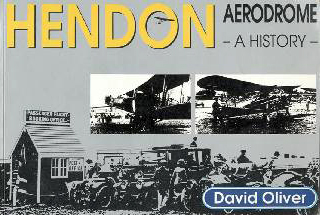|
|
Today, the Grahame Park housing estate
covers the majority of the site, but the RAF Museum keeps
alive the spirit of those early days of Hendon Aerodrome. In
1910, as owner of the Aerodrome, Grahame - White established
the first London Flying Club on 207 acres of North London
pasture, thus beginning the long history of aviation at
Hendon. However, in 1916 the War Office took over the
civilian schools on the Aerodrome to form the Royal Flying
Corps Civilian School of Instruction and this effectively
marked the end of civilian training at Hendon. Thus, later
references to the 'London Flying Club' probably mean Stag
Lane Airfield.
|
|
Here follows an outline study of the area, with key dates...
Rather less well known is the smaller airfield and factories from which
the De Havilland aircraft were built and from which the flying pioneers
of the 1930s were trained...
Claude Grahame-White
(1879-1959)
- In 1909, he became the first Englishman to gain an
aviator's certificate.
- He was also the first British pilot to fly at
night.
- In 1910, as owner of the Aerodrome, he established
the first London Flying Club on 207 acres of North London
pasture, thus beginning the long history of aviation at
Hendon.
- In September 1911 the Grahame - White company
operated an experimental air mail service for two weeks
between Hendon and Windsor. As well commemorating the
coronation of King George V, and raising money for charity,
the event publicised the possibilities of the aeroplane as a
means of transport.
- In 1925 Grahame - White's London Flying Club
closed to become part of the 400,000 sq ft of property which
was leased (short term) to Standard Telephones and Cables
Ltd.
- Eventually Hendon was sold to the Air Ministry.
- Aerodrome Road, separated some driving school
garages from the disused Hendon Aerodrome. For a while the
old runways were used by the driving school for students to
practice their road skills.
- During the 1970s, Grahame Park - a mixture of
flats, town houses and terraced housing was built on the
site. Was ordered as a result of international competitive
tendering.
|
RAF Hendon
- In 1914 the field was taken over by the Admiralty and
became a Royal Naval Air Station.
- On 1st April 1918 The
Royal Flying Corps and the Royal Naval Air Service
amalgamated to form the Royal Air Force.
- In 1927 the site
became an operational RAF station.
- On 17th March 1930, 604
Squadron was established:
- F/L F.J. Fogarty as adjutant and flying instructor.
- A Warrant Officer.
- 19 Airmen
- Hendon
remained a major airfield throughout both World Wars, and
afterwards it acquired an international reputation as a
centre of aviation, through the staging of spectacular
aerial pageants.
- On 4th November 1957 the airport ceased
operations and entered a gradual decline. Eventually, the
airfield was swallowed up by the concrete jungle of modern
housing, with the Grahame Park Estate covering the majority
of the site.
- On 15th November 1972, the RAF Museum on
Grahame Park Way was officially opened by Her Majesty Queen
Elizabeth II.
- The Museum occupies two of the original WWI Royal
Naval Air Service hangars.
- In 1974, Graham - White's
London Flying Club's buildings were finally torn down to
make way for expansion of The Hendon Police College.
- The extensive collection on display includes everything from
the basic stick and fabric planes to sophisticated jets.
- In 1978, The Battle of Britain Hall was opened, followed
by the Bomber Command Hall in 1984.
- The Queen Mother was
present at a ceremony to mark the official closure of
the Hendon Aerodrome on 1st April 1987.
|
References
 |
Hendon Aerodrome by David Oliver (Airlife publishers) 1994
(168 pages): Traces the history from Grahame - White's
factory to the present site of the RAF Museum.
|
| |
|
Links
History of Grahame-White Factory
RAF Red Arrows
|

